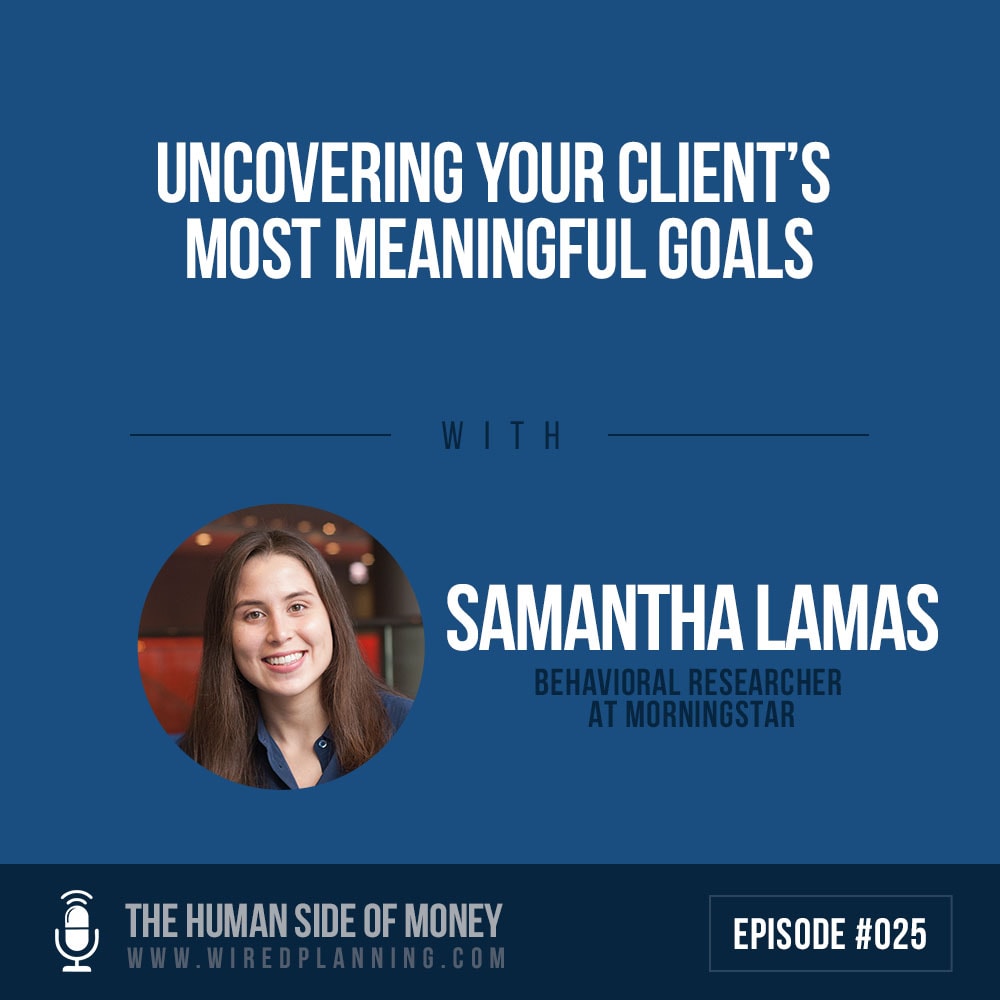Show Links
*If you want to be notified when the next episode packed full of practical tips and strategies to master the human side of money will be released, you can:
- Subscribe to the Show
- Join the community of like-minded advisors and planners across the world being notified via email. In addition to podcast releases, you’ll get our monthly “Wisdom Round Up” where we deliver to you the best content from around the industry on applying behavioral finance and mastering the human side of money.
Episode Summary
From financial planning software providers continuing to focus on adding goals-based features to the widespread adoption of a goals-based approach at the firms that have long been notoriously associated with investments, goals-based planning has been and continues to be on the rise throughout the industry.
The success and effectiveness of a goals-based planning approach is contingent upon the successful execution of two things:
- Identifying the most important goals
- Prioritizing those goals
The best strategy or portfolio is useless if aligned with the wrong goal. It’s the equivalent of hopping on a plane that takes you to New York when you needed to be in San Francisco.
Which means advisors should be spending equal amounts of time and effort on goal identification and prioritization as they do the strategies and portfolio construction. Simply asking clients what their goals are isn’t the solution.
The behavioral finance world spends the majority of its time teaching you about the behavioral biases that impact financial decision-making. But far less time, attention, and focus has been spent highlighting the fact that behavioral biases or blind spots can undermine the process of identifying and prioritizing goals!
Samantha Lamas and her colleagues at Morningstar conducted an award-winning research study addressing the behavioral biases that threaten the goals-based planning process, and more importantly, developed and tested a solution to help overcome this problem.
They discovered that there is indeed a gap that exists between the goals clients think they want and the goals they actually want. The goals that are truly relevant and important to them.
For example, you may have a meeting with a couple who walks in on a Monday morning after spending their Sunday afternoon at a house-warming party. When you ask them what their goals are, their experience from the house-warming party yesterday (availability bias) is top-of-mind, and thus, they list buying a new home as one of their goals. But had you asked them on Friday, it wouldn’t have shown up in their top 3.
The implications of these results are massive. As we said earlier, the success of goals-based planning hinges on the ability to identify and prioritize goals. Yet, the majority of people don’t actually know what their true goals are.
Fortunately, Samantha and her team conducted an experiment to see if they could behaviorally nudge clients to better identify what’s really important to them. They gave them a master list of common goals to choose from.
Once provided with the master list of goals to choose from, most people’s goals became more personalized, specific and emotionally grounded.
If you want to do goals-based planning, then the first thing you have to do is identify personalized, specific, and emotionally-grounded goals. Otherwise, you might be missing the mark.
Things You’ll Learn
- The details and results behind the award-winning research from Samantha and her colleagues on the importance of a master list of goals
- Why humans are ill-equipped to know our goals and the biases at play when trying to identify goals
- Exactly how advisors can take the research and apply it in their meetings to help clients identify their most important goals
- The behavioral benefits of goals-based planning
- How a master list of goals makes goals more personal, specific and emotionally-grounded
- How many goals is too many at one time and what the sweet-spot number is
- Samantha’s own story of being asked by an advisor what her goals were and how it shaped her thinking
- Why clients rank “Helps me stay in control of my emotions” the least valuable attribute of an advisor
- How rephrasing the value of behavioral coaching led to a significant change in the perception of value
About Samantha Lamas
Samantha Lamas is a behavioral researcher and columnist at Morningstar. She’s worked on some of the most highly-regarded and highly-renown research projects in the industry over the last several years.
Other Episodes You’ll Like on Discovering What’s Truly Important to Clients
- Episode 11: An Evidence-Based Approach To Winning Prospects and Influencing Clients (Part 1) with Evan Beach
- Episode 31: A 5-Step Process For Syncing Financial And Emotional Well-Being with Amy Mullen
- Episode 47: A Values-Based Financial Planning Process To Attract And Acquire Ideal Clients with Bill Bachrach
Resources
- Samantha Lamas Morningstar
- Samantha Lamas Twitter
- Samantha Lamas LinkedIn
- “Behavioral Nudges for Goals-Based Financial Planning” by Samantha Lamas
- “Identifying What Investors Value In A Financial Advisor: Uncovering Opportunities And Pitfalls” by Ryan Murphy, Samantha Lamas, and Ray Sin
- “Benefits of Goals-Based Planning for Advisors”
- Gerd Gigerenzer
- Katy Milkman
- Scarcity: Why Having Too Little Means So Much by Sendhil Mullainathan
Whenever you’re ready, there are 3 ways I can help you master the human side of advice:
- HSOA Masterclass: An 8-week group program on building trust & connection, aligning money and life, and delivering frictionless advice.
- The Ultimate Discovery Meeting: A proven framework to seamlessly convert prospects into life-long clients in one meeting.
- HSOA Community (COMING SOON!): An online space to meet, collaborate, discuss, brainstorm, learn and grow with other advisors passionate about the human side of advice
If you’re interested, let me know here.

